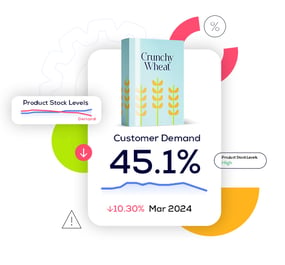How to tackle inventory drift with advanced inventory systems

- 5 minute read
- Retail Insight Team
Inventory drift is the gradual loss of accuracy in your inventory system. It occurs when stock levels do not align with target sales due to shifting consumer demand over time.
To gain visibility and track inventory drift, many retailers turn to perpetual inventory management systems. Rather than relying on periodic manual audits and stock counts, the perpetual inventory system links to a point-of-sale (POS) system to constantly track sales and automatically update inventory records.
Perpetual inventory systems can be a time-saving and efficiency game changer for retailers. Automatically updating inventory counts based on continual tracking of sales and inventory changes can deliver many benefits to stores - from optimizing manual labor costs to reducing warehouse storage space to more accurate forecasting and replenishment. It’s also the best way to prevent out-of-stocks, improve customer satisfaction, and protect loyalty.
Despite the many benefits of this technology, retailers still struggle to account for inventory drift. The problem is that perpetual inventory systems can’t natively account for process errors or theft, which means that over time, the system’s accuracy gradually degrades.
Mitigating the inevitability of inventory drift
Sadly, it shouldn’t be a surprise when you consider the volume of things that can happen before an inventory record is updated. Many of these errors are inevitable, day-to-day processes that grocery retailers simply can’t avoid or plan for.
Incorrect manual counts, accidental and unrecorded damage on the store floor, and unexpected delivery delays are examples of major contributors to inventory drift. In these cases, unless store associates manually update inventory systems, stock records won’t account for them. The result? An inaccurate inventory record, where errors are tough to pinpoint and resolve.
With the adoption of automated perpetual inventory systems retailers begin to realize the estate-wide benefits automated systems provide. But simply having a historical or real-time view of inventory data doesn’t solve for drift - unless advanced predictive modeling technology comes into play.
Here, we explore the several key advantages inventory management systems deliver to retailers when employing advanced AI and machine learning models to help these systems predict and correct inventory drift.
Detailed, trackable history
Less sophisticated inventory systems rely on manual audits that are notoriously unreliable and are immediately out of date. Physical counts, paper-based audits, and re-order card processes can sometimes be opted for due to budget constraints, but these human-error-prone systems lack accessible historical data trends.
A perpetual inventory system, on the other hand, provides instant access to a wealth of stock history at the click of a button to see historical patterns and trends. However, historical data is only useful if it has accounted for and corrected record inaccuracies. By leveraging machine learning models to predict and understand where record errors might have occurred in the past, you gain a more accurate view of your historical stock levels. Only then can you truly start to identify bottlenecks in your processes and equip teams with the knowledge needed to optimize your supply chain.
Smarter, more accurate forecasting
Using a perpetual inventory system across your entire estate offers significant advantages for forecasting and replenishment. It can identify product-level and store-level trends, which leads to more accurate forecasting. However, these systems still face limitations in predicting inventory inaccuracies. What does this mean? They may not fully capture the dynamic nature of consumer behavior and market trends, leading to potential stockouts or overstock situations.
In contrast, inventory systems enhanced with AI and machine learning capabilities monitor data in real-time and predict and correct inventory inaccuracies - adapting to changing patterns as they happen. This not only ensures a more efficient supply chain but also enhances customer satisfaction by keeping shoppers' carts filled with their desired products precisely when they want them.
This approach is particularly valuable during seasonal peaks, as it ensures you have the ideal inventory levels for the right products at the right times. As a result, you'll see increased sales and less waste, and your inventory management system will become more resilient and responsive.
Preventing process brain drain
Manual inventory management often requires extensive training, and doesn’t cover topics that help staff understand and identify when inventory drift can happen, or how to update records accordingly. Yet, amidst high employee turnover and increased labor productivity pressures, the degree of training required is often difficult for retailers to administer. This often results in inaccurate records and inventory drift leading to losses.
Sophisticated perpetual inventory systems require less training and help ease the issue of brain drain when more experienced associates leave the store by preserving core drivers of inventory drift knowledge within the system itself. The automated nature of the perpetual inventory system means that complex understanding won't be lost when tenured employees are replaced with less experienced associates.
Overall, advanced inventory systems can significantly reduce the amount of time and money spent on inventory management. These systems automate a large volume of processes that would otherwise be manual, optimizing labor costs and freeing up store associates’ time to focus on higher-priority tasks.

How to get the most from an automated inventory system to prevent inventory drift
The cost-effective advantages of an automated inventory management system are indisputable. But to truly optimize this technology, it is crucial to identify and correct inventory drift. AI and machine learning tools that predict and correct inaccurate inventory levels can help make informed decisions and avoid costly stockouts or overstocking. Finding the right and most accurate solution is important.
At Retail Insight, we’ve developed InventoryInsight, a solution that goes further than delivering visibility of your historical inventory figures. Using the power of cognitive technology, we connect to your stores’ data and predict with precision how likely an inventory record is to be accurate and why.
Our predictive modeling automatically corrects your inventory systems, equipping you with the knowledge needed to recognize anomalies that are a direct result of inventory drift. It alerts you to specific instances where process errors haven’t been considered within your update processes. With a smarter perpetual inventory management system, you can prevent inventory drift with insight instead of instinct.
Find out more about how Retail Insight’s AI and machine-learning platform can streamline your inventory management, estate-wide.
Get in touch
Written by Retail Insight Team
Retail Insight takes data and turns it into action. Our advanced algorithms unlock valuable insights that drive better decision-making for retailers and CPGs.